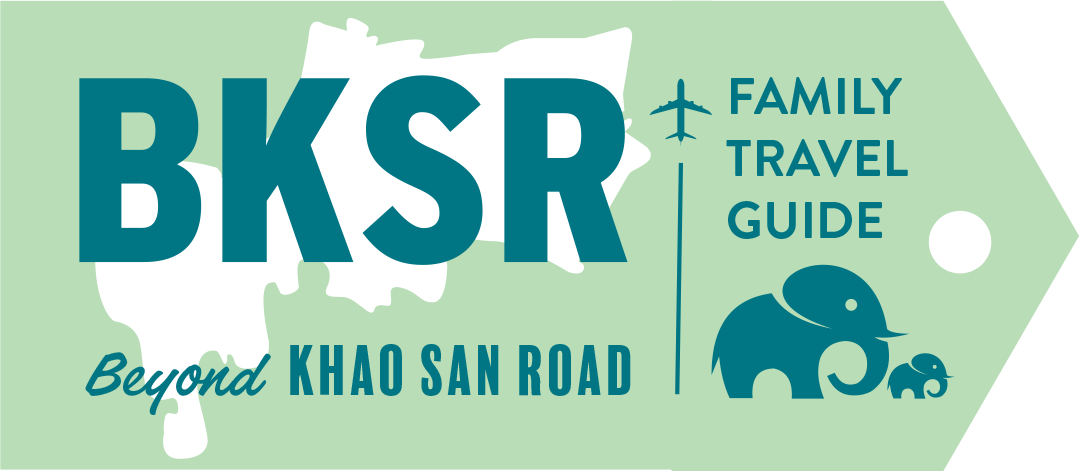Long-term travel with your kids is sure to be an educational and exhilarating experience, but let’s be honest, packing for a long-term trip away can be a nightmare! The list of “essentials” seems endless, and trying to fit everything into your backpack feels like a game of Tetris. Having read and tested just about every long-term travel packing guide for families out there, it’s safe to say that finding the perfect balance between preparedness and practicality remains an ongoing adventure.
However, worry not! With a little planning and a hint of lateral thinking, you can master the art of packing for extended trips with children. In this detailed guide, we will run through the tips, tricks, and strategies we have developed to make packing quicker and less stressful. We will also explore what you might need to take and some packing pitfalls to avoid.
Read on for our ultimate long-term travel packing guide for families!
Top Tips for Packing When Traveling Long Term with Kids
All the tips below have come from our experiences on the road and have been tried and tested in a hundred hotels and hostels on our travels. They have saved us time, money, and countless headaches and made our life much easier when living out of a backpack.
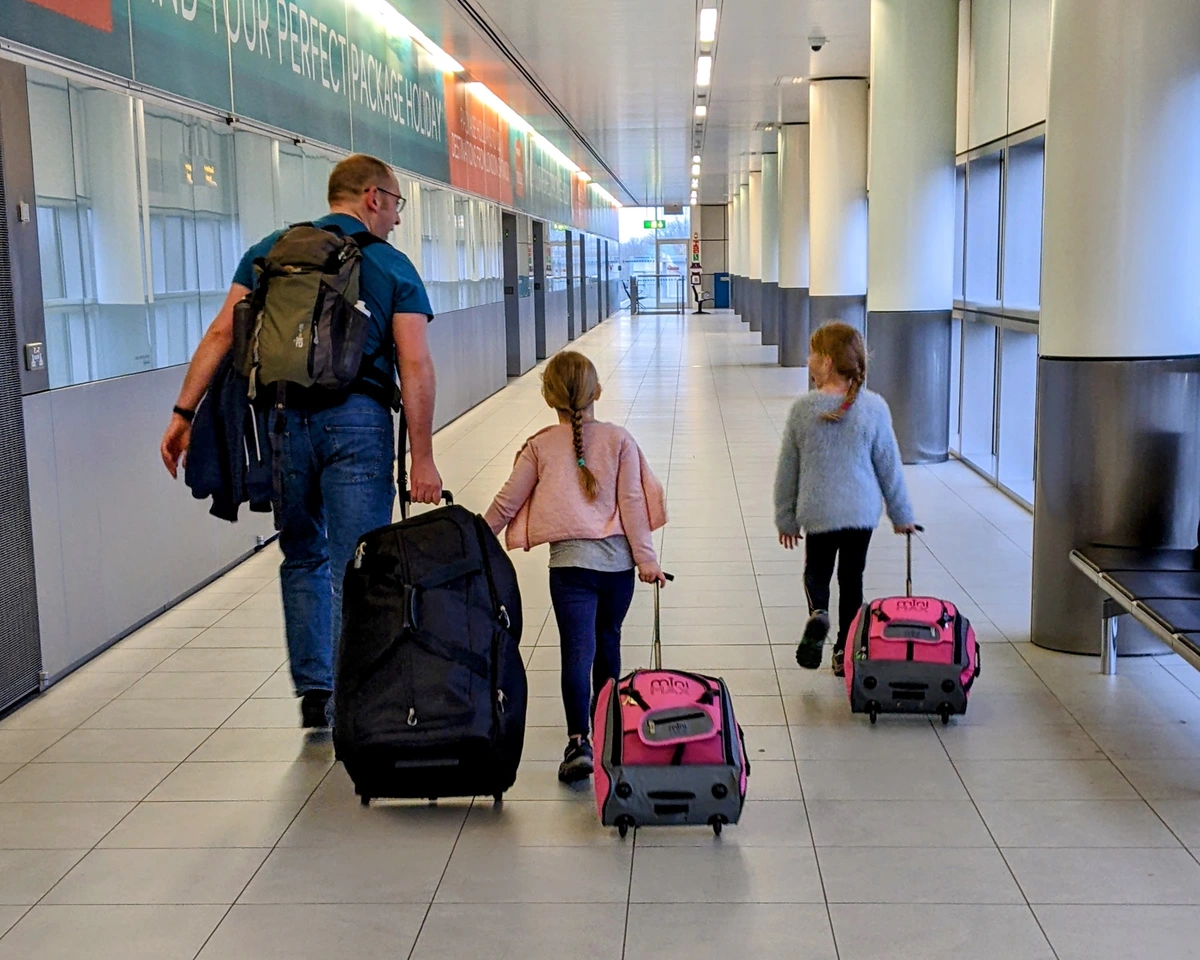
The Three Most Important Things to Consider: Weight, Weight, and Weight.
When you start to pack for a long-term trip, the weight of your bags can mount up very quickly. Fortunately, there are some really simple things you can do to cut down on what you have to carry:
- Start planning early – By creating a family travel packing list and shopping around, you get a chance to think about what you really need and look for lightweight alternatives.
- Invest in a lightweight bag scale – This will help you track your luggage weight as you pack and help you understand what is adding the lbs to your backpack. You can also bring it on the trip, so you don’t get caught out at the airport when you repack.
- Clothes are heavy; pack light layers, not bulky coats – Thin layers weigh less, compress smaller and are far more versatile than bulky layers, so you can carry less and be more adaptable.
- Pack versatile items – The more things an item can do, the less you need to carry; for example, we have lightweight down puffy jackets that stuff into a compression sack and can be used as a great travel pillow. A deck of cards can be used for many different card games.
- Limit the number of chargers – If everything has its own charger, it adds even more weight as you drag around cables and adaptors. We make sure nearly everything we take is USB-C, so we only need a couple of chargers with us, saving us a lot of carry weight.
- The biggie! Ask yourself the most challenging question – “Do I really need it?” – It is far better not to bring something and then buy it as you travel than to bring something that never leaves your bag.
And this last tip leads us nicely on to…..
What You Don’t Take is Almost as Important as What You Do Take
What is better than something light? Something that weighs nothing at all because you left it at home!
There is a strong temptation to overpack when going away on an extended trip with children, especially younger children. We made this mistake on one of our early adventures with the girls when we took a ridiculous number of nappies and wet wipes, as well as enough baby food to last for months. The crazy thing is, we were going to Australia, a country replete with excellent baby facilities.
Kirsty calls this “what if?” thinking and it is an easy trap to fall into, especially with young children. What if we get stuck in an airport for 10 hours? What if Eva is allergic to the baby wipes over there? What if Georgia doesn’t like the food?
It is so easy to overthink and overpack for worst-case “what if?” scenarios that almost certainly will not happen. Pack some spares, certainly, but don’t overdo it!
To fight the “what if?” thinking, ask yourself if you have packed any items you don’t expect to need within the first week of your trip.
If yes, you probably won’t need them at all so they can be safely left behind.

Beware Pointless Items That Will Weigh You Down
Even during our pre-children journies, we both took things that never left our bags the entire time we were away. Astonishingly looking back, we still carried them around for a year because we might need them. The main culprits of useless weight were:
- Outdoor Equipment – We hauled along bulky hiking gear like mosquito nets, travel hammocks, and even water purification flasks. Unless you are crazy enough to drag your kids for an unguided week-long jungle trek, you will not need any of it. It will just sit in the bottom of your bag as a dead weight. Any time you need equipment like that, it will be provided by the tour company, or you will be able to hire/buy it locally.
- Shoes – The easiest way to add pointless kilos to your luggage is to take too many shoes. The temptation to pack for every eventuality is strong, but we travel with good walking shoes and sandals or flip-flops. We rarely need anything else.
- Excessive Toiletries. For some odd reason, when Adrian packed to go on his first round-the-world trip, he thought he wouldn’t be able to get shampoo or deodorant in South East Asia, so he packed enough for six months. His first hostel was next door to a 7/11. The only exception to this toiletries rule is sunblock, which can be very tricky to get hold of in some parts of the world. It is well worth taking a surplus.
At the heart of packing for a long trip is a simple question, is it worth the weight?
For every item in your bag, try to balance how much it is needed vs. how much it weighs.
Be ruthless. If you are at all uncertain, then don’t take it. If it turns out you do need it, you will almost certainly be able to buy it on the trip.
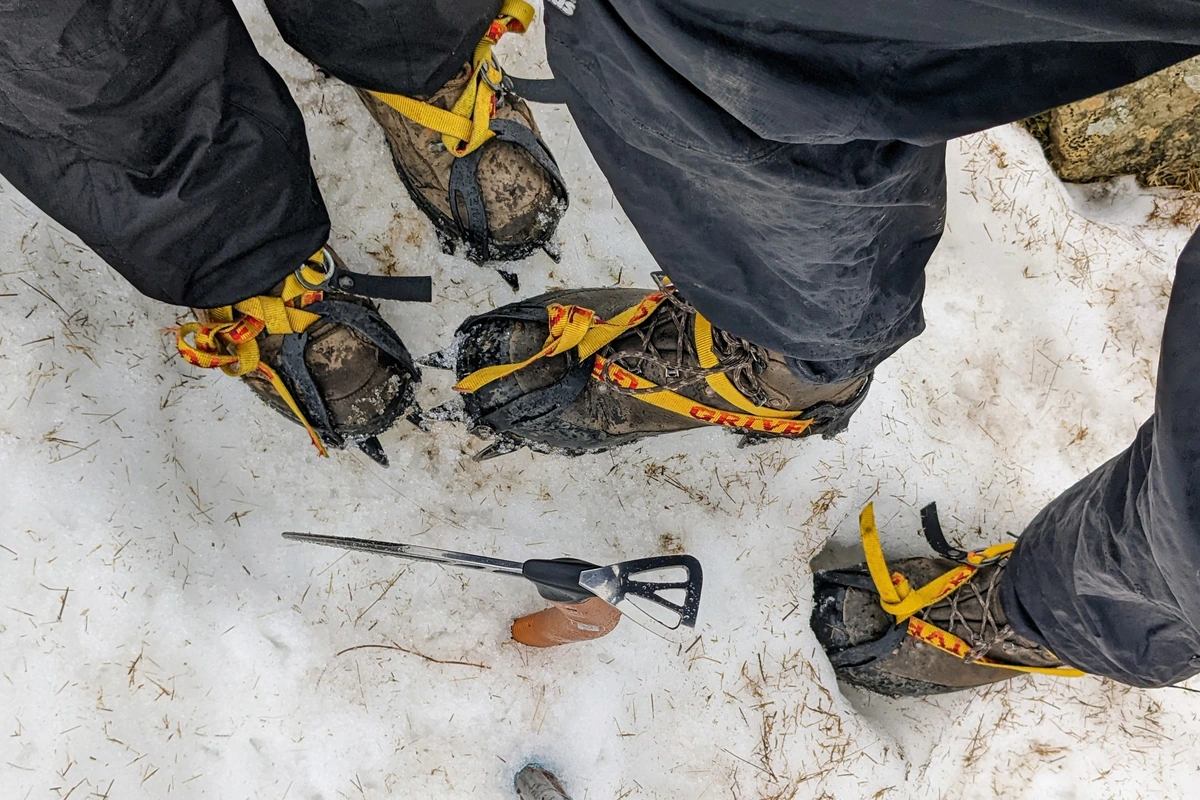
Avoid Accumulating
If you figure out how to do this, let us know! As you move about, there is always a temptation to pick up souvenirs and nick-nacks, especially when you find yourself in a gift shop with the kids most days.
With Georgia and Eva, we made it clear from the start of our trip that getting any new toy would be a rare treat, and anything they bought had to fit in their bag and carry themselves.
This is not to say we don’t collect memories or keepsakes; we just try and keep things like tickets and paper maps with the odd coin, key ring or banknote as well.
Inevitably, however, these trinkets will accumulate, so you will need to…..
Have Regular Clear Outs
Once you have settled on your ultimate packing list, try and stick to it! When you are enjoying full-time travel, having a clear-out every few months is necessary to declutter and reduce weight. It also keeps things safe and sound and means when you get home, you can open the boxes and rediscover all the memories!
We would also recommend having a clear-out after your first few weeks of travelling. Not only do we find we tend to accumulate more at the start of a journey as we bed in, but by that time we have a good idea if we have packed anything that we don’t need.
If, like us, you have sold your home before travelling, you will need a friend or family member who will happily accept and store them until your return.
The Joy Of Packing Cubes – Staying Organised While Travelling
When you are away for an extended period, it seems like it only takes a few days for your beautifully packed bags to descend into chaos, especially when your children dig through them, looking for their favourite pair of pants.
This is where packing cubes are an absolute revelation; once you have travelled with them, you will never know how you used to manage without them. If you have not heard of them, packing cubes are essentially square fabric bags with zips you can use to organise the contents of your bag. You can have one for tops, one for swimming gear, one for chargers, one for waterproofs, etc.
For the kids, they are just brilliant. When you arrive at a new place, it takes 10 seconds to unpack; you know exactly where their pants, socks, and trousers are. It keeps dirty washing together, and it makes repacking to leave about ten times quicker! Zip up the cubes, throw them in your bag, and you are away.
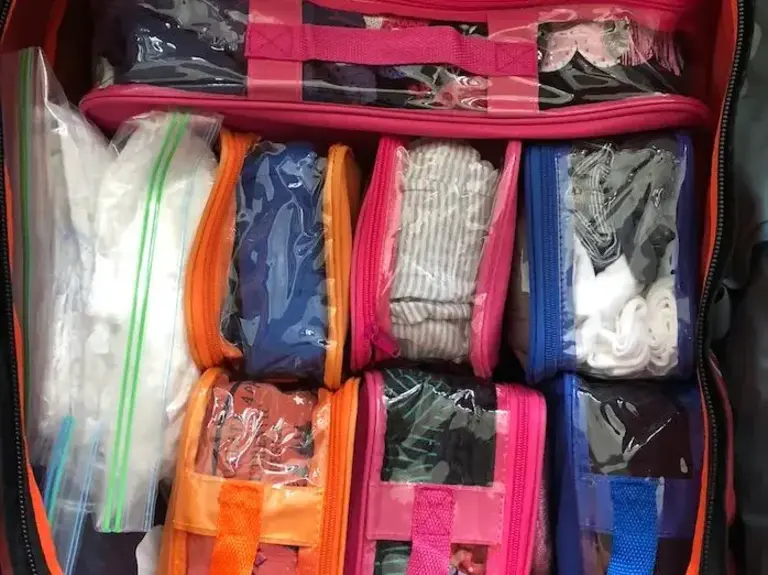
They do add a little weight, but the simplicity they bring is well worth it. We have tried a few different types of cubes and found some to be too small or not tough enough for life on the road.
Ultimately we settled on these by G4Free, which are a useful range of sizes, rugged and come in just about any colour you want.
Travelling with Camera Equipment
The very toughest packing decision we took was on camera gear. For Adrian, as a former professional photographer, the thought of travelling without a DSLR was, well, unthinkable.
Adrian has photographed weddings in Ireland, Cuba and even Australia so knows from experience that the problem with travelling with professional camera equipment is that it is never just the camera. It’s the lenses, the filters, the batteries, and the flashes. It’s a constant worry when the gear is left unattended. It is the constant risk of it being broken or being lost on a flight. It is the cost to replace. Oh, and it weighs a lot!
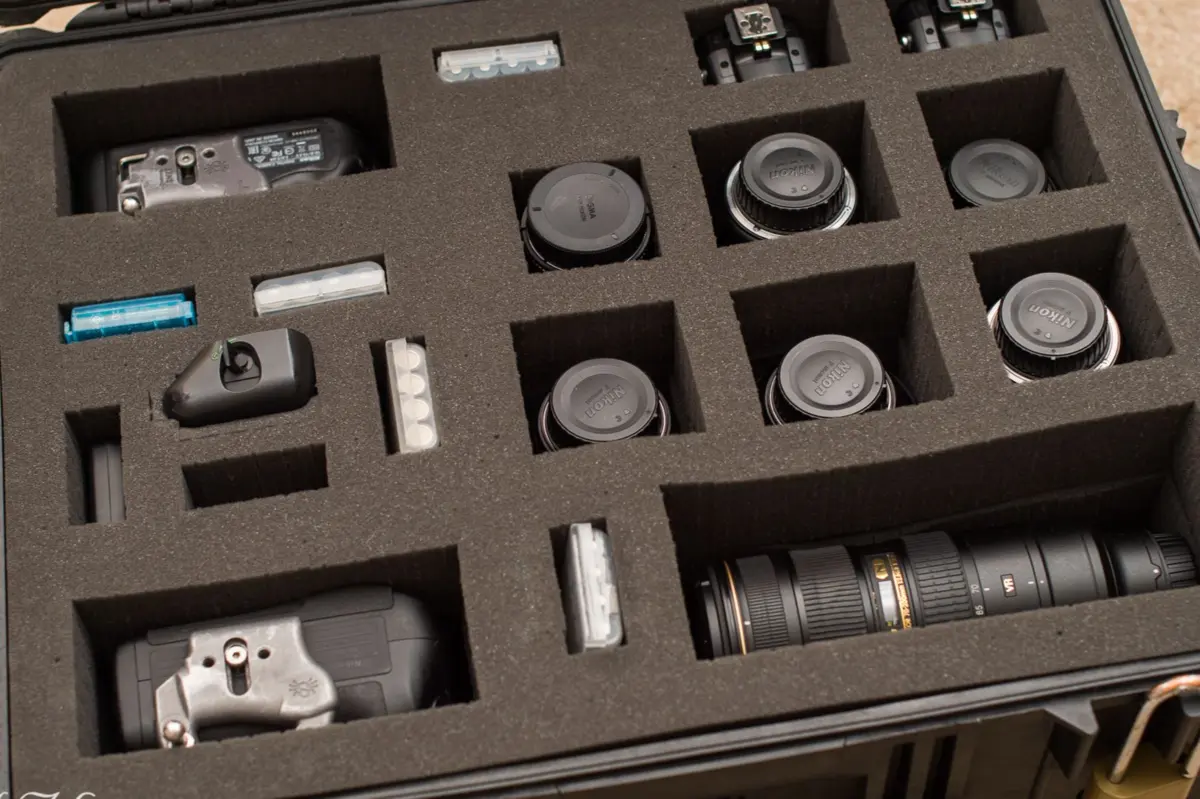
Ultimately, we decided to leave all the camera equipment at home and rely on our phones for pictures. Are the pictures as good as a DSLR? No, but we saved over 6kg in weight and a whole lot of worry.
How Much Can Your Children Carry?
This question will have a big impact on your packing!
One of the things we have noticed is that as Georgia and Eva have gotten older, the easier packing for them has become. Not only do they need less, they can carry more! The older your children are, the more flexibility you get in your packing and planning.
At one end of the scale, travelling with babies and toddlers adds a huge amount of weight. The nappies, wipes, creams, changing mats, expressing machines, formula, and other items really add kilos and take up space. Although we did take several long-haul flights with the girls at this age, thanks to Covid we never travelled long-term with the girls when they were in nappies so we do not feel qualified to give packing advice specifically for tots.
If your children are in preschool, then you need to work on the assumption that you will be carrying everything yourself. If they are a bit older, then perhaps they can carry some items. Now that Eva is 7 and Georiga is 9 they usually carry around 10kg each in their luggage. If your children are tweens or teens, maybe they could carry even more.
One word of warning, Eva and Georgia are still at the age where they can run out of steam or have what we like to call “a sense of humour” failure. On the rare occasions these occur, we usually end up carrying their bags ourselves.
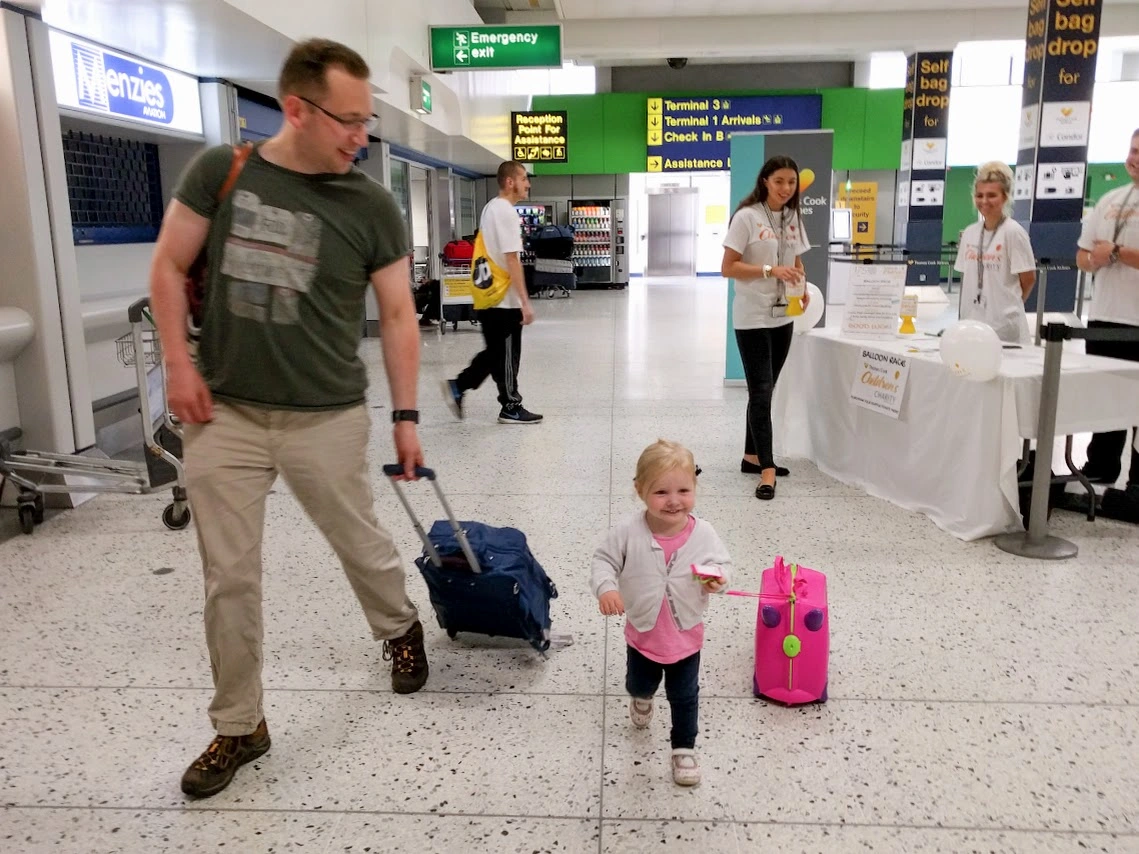
Now we have run through our approach to packing, time to talk specifics!
What to Pack?
Everything you will take can be roughly grouped into one of seven categories:
Splitting the packing into these groups helps plan what is needed and see which category adds the most weight.
Bags
Adult Main Bags
When it comes to the bags for adults, your choices are backpack or wheeled luggage.
What you decide on depends on the sort of trip you are planning. Wheeled luggage can, at times, certainly make life easier. They are great for airports and for use in most Western cities. They also take a lot of pressure off when you end up carrying your children’s bags, which is sure to happen occasionally.
Unfortunately, the deal breaker with wheeled luggage is that as soon as the path gets slightly rough, they go from being an advantage to a massive liability. Something as simple as a gravel road will lock up the wheels, and because they are designed to be rolled not carried, you can’t easily fling them on your back. Instead, you end up dragging and breaking them.
In Europe and the US, we are used to towns with wide pavements and wheelchair-accessible ramps. The vast majority of South America, South East Asia, and India is yet to catch up with this idea, making wheeled bags deeply impractical in these parts of the world. Worst of all, because the pavements are so bad, wheeled luggage encourages you to walk on the road putting you in danger.
Backpacks are the only sensible choice for any trip outside Western cities, and they offer flexibility no matter the terrain. Another thing to consider is that in most of the places you will need to carry your backpacks a significant distance, like airports, then luggage trolleys are available.
Backpacks do have some disadvantages. When you check them in on a flight, many airlines won’t accept them at the usual bag check, and you have to take them to the oversized baggage lane. This can involve queuing a second time which could be a problem if you are in a rush.
Another disadvantage of backpacks is they are not as easy to live out of as traditional luggage as they are not as accessible. Any items that are not in daily use tend to get buried down the bottom. If you use packing cubes as recommended above, it makes life much easier!
We also looked at hybrid backpacks with wheels, but after trying them out, we decided they are the worst of both worlds. The inclusion of wheels makes them very heavy (nearly a kilo more than a dedicated backpack in some cases), and they are uncomfortable to wear due to the rigid structure.
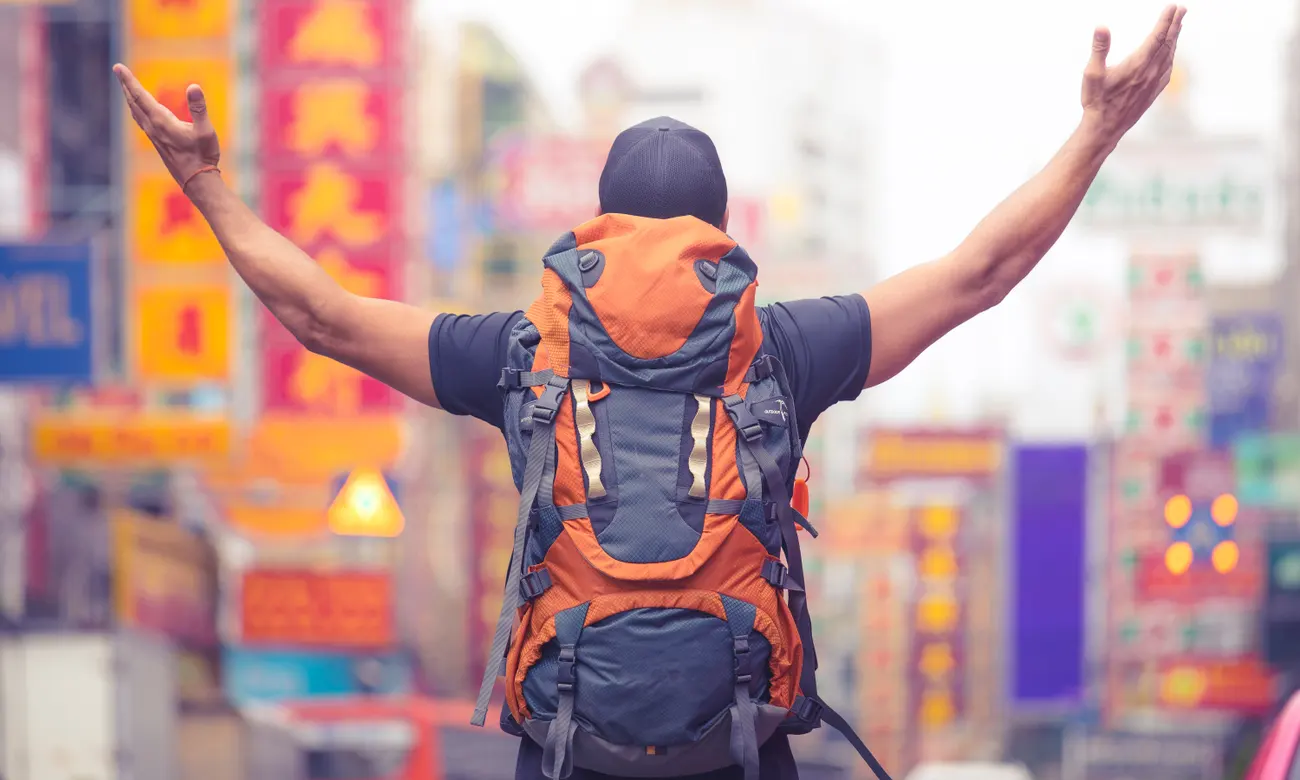
Adult Main Bags Recommendations
Adrian bought a British army surplus 100L DPM Bergen way back in 2007, and it is still going strong despite being dragged through more airports than he can remember! It has a vast 100l capacity, huge side and top pockets and is reasonably comfortable to wear for extended periods. The only complaint would be the lack of an access zip at the bottom.
British Army 100L DPM Bergen Long Back With Side Pouches
After years with a 50ltr Berghaus bag, the packing demands of the kids have necessitated an upgrade! After much shopping around, Kirsty has gone for an Osprey Women’s Fairview Trek 70. Kirsty is a huge fan of the suspended back which makes it very comfortable to wear, and it opens up like a suitcase, so living out of it is that much easier. Also, it has a cleverly integrated daypack that either lashes on the back or front.
Children’s Main Bags
As discussed above, the bag you choose for your children will depend entirely on how much, if anything, they will be carrying.
For Georgia and Eva, we wanted something with wheels they can roll, straps so they can be worn as a backpack, big enough to take around 10kg of luggage, sturdy enough to check in as hold luggage, but small enough to take on as hand luggage. Also, the bag had to be easy for us to carry should we need to step in and shoulder a load.
Quite a list of requirements, but several such bags exist!
Children’s Main Bag Recommendations:
The Aerolite MiniMAX 30L has been brilliant for the girls. It does everything above, doesn’t look too babyish or features cartoon characters that fall out of favour. The build quality is reasonably rugged, although we don’t expect it to last the full trip without being replaced!
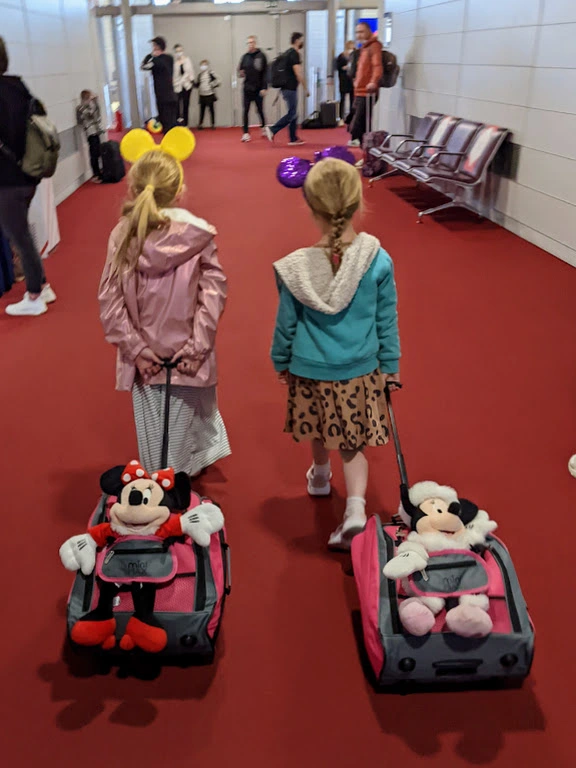
Adult Day Packs/Hiking Backpack
A comfortable, well-fitting day pack is the most important bag you will have when travelling. Your day pack will spend far more time with you than your main bag and will be your go-to when exploring new cities, trekking through jungles, voyaging over salt flats, or being used as carry-on luggage on a plane.
When travelling with children, you will need a slightly larger pack as you will have more to carry, like extra water, snacks and spare clothes. We have found that the sweet spot is between 30 & 35 litres capacity, which is a nice compromise between carry space and compactness.
More than anything, it needs to be comfortable. This bag will be living on your back day in, day out, so this is not somewhere you want to compromise. Try before you buy, and don’t settle. There is no shortage of manufacturers of bags, so shop around and see what works for you.
Other features to consider are a hydration bladder compartment, sizeable side pockets for water, laptop compartments and its overall weight.
Adult Day Packs/Hiking Backpack Recommendations
Kirsty went with the Osprey Unisex Daylite Plus, which is comfortable to wear and attaches to her main bag on either the front or the back.
Osprey Europe Unisex Daylite Plus
Adrian has finally retired his trusty Lowe Alpine back after over a decade of usage as it is just a little small and has gone for the Osprey Men’s Talon 33 Hiking Pack. It is a great size with plenty of space for water, snacks, a first aid kit or to use as an overnight bag. It is a little convoluted to get in and out of but feels great on the back.
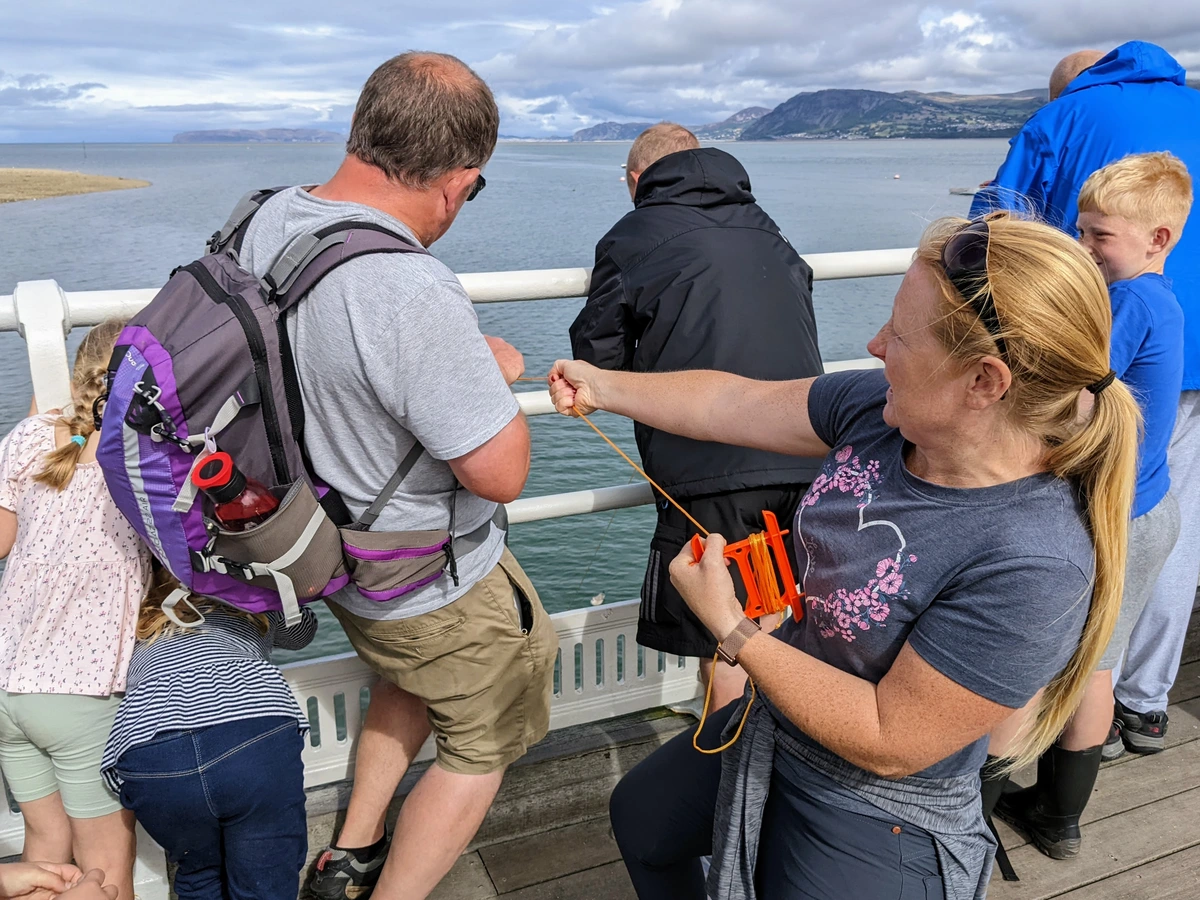
Kids Day Packs
The big problem we have found with children’s day packs is that they are pretty much all absolutely crap. They have a terrible build quality and an uncomfortable fit once they have any weight in. As far as we can tell, they seem to be manufactured only to last a short while and so fall apart after a few uses.
The first thing to fail is always the side pocket where the reusable water bottle sits, usually followed by the stitching on the main strap. We have tried half a dozen different brands, and it is always the same story.
Kids Day Packs Recommendations
After much trial and error, the least worst we have found is the Eurohike Ratio 10 which is a useful size and comfy for the girls to wear. The only big problem with this pack is that the side pockets are too small for a water bottle, so it has to go inside the bag.
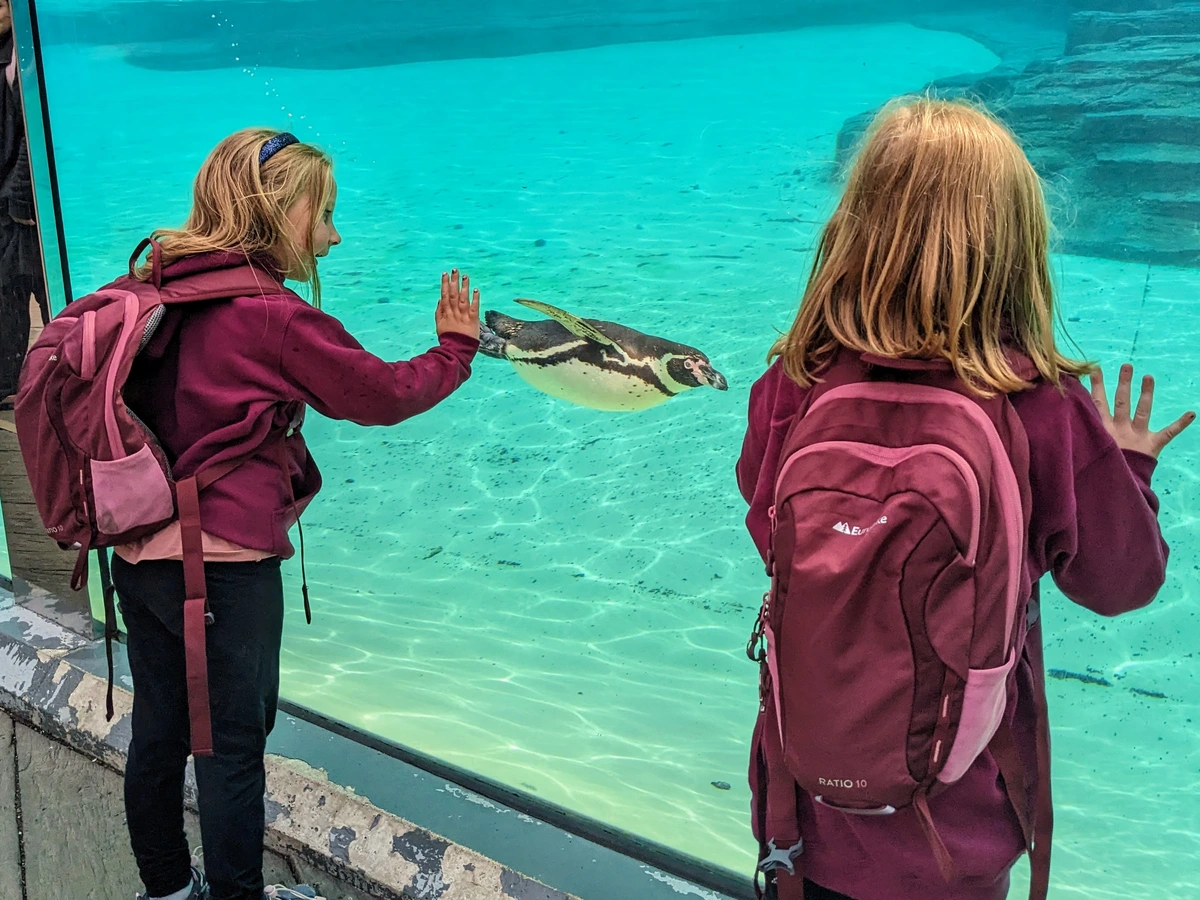
Clothes
Choosing the right clothes to take travelling can be a real challenge, even for seasoned travellers. It is even harder when you have got children whose needs and wants are ever-changing.
The clothes you pack for a long trip differ greatly from those you would pack for a holiday; on holiday, you will be in a largely consistent climate and plan on being home in a few weeks. On a longer trip, the challenge is to condense an entire wardrobe into just a few kilos. You need to pack for warm weather, cold weather, wet weather, pack some extra clothes just in case, and you need to carry everything on your back!
Many of the luxury and ‘what if?’ items we would pack for a holiday are just not practical for extended travel.
Clothes technology has come a long way recently and even the tops and trousers we bought a few years ago have been superseded by new, lighter-weight, breathable fabrics meaning clothing has become a lot less bulky. Even if you are on a tight budget, there are clothes out there that will save weight and not break the bank, whilst also being a pleasure to wear whilst you are away.
As discussed above, the first thing to do is put some thought into what are your necessities for your trip and strip everything back to the bare bones.
What Clothes To Pack
Exactly what you pack depends on where you are going. With our girls still under 10, we have opted not to visit any extremely cold areas. Most of the countries we are visiting are around the equator and will be pretty hot by UK standards (not that that means much! We are from Manchester and anything over 17℃ is hot for us!) so most of our clothes will be lightweight. That said, even in hot countries, there are always some chilly evenings, draughty airport lounges or flights where the air conditioning is on too low, so we will certainly need a few warmer layers.
We have also opted to travel to a few areas where the time of year and/or the area will mean we can expect a cooler climate. We plan to spend time in Patagonia, at altitude in Bolivia, travelling around New Zealand during the shoulder season & to Nepal. In areas like this, layers are the key. Rather than carrying heavy coats for the periods we require warmth, we will carry a number of thin, lightweight layers that we can stack and a windproof outer layer.
So what are we taking? As a rule, we carry enough clothes to see us through 7 days to allow us to survive for five days with two days in the bank to wash and dry. This bulk of our clothes comprises a combination of strappy, short and long sleeve, lightweight tops/t-shirts. The emphasis is more on the short-sleeve options with only two long-sleeve layers.
For the bottom half, we will be taking a combination of full and three-quarter length lightweight walking leggings/trousers. Kirsty swears by ACAI legwear, which is specifically designed for women and is very hard-wearing but is quite pricey. Adrian favours Craghopper for comfort and durability; they are reasonably priced which is a bonus.
For the girls, we often go for cheaper brands like Mountain Warehouse or Decathlon. As they outgrow clothes so quickly, we don’t see the point in spending a huge amount! They also have their favourite ‘Harry Potter’ hoodies which are pretty thin, and they love them so we are happy to take these.
Kirsty also has an amazing Dare2B Women’s Sprint City Lightweight Hoodie. It is super thin, barely weighs anything and has a hood which is great as I hate getting cold ears! It is perfect when I need a bit extra whilst out and about. It has also proved to be a great wind layer whilst hiking at altitude. It is absolutely top of her list!
Other useful lightweight items we have packed are buffs and light-down jackets with hoods. We went with Rab Alpine Jackets that are incredibly warm, especially with a base layer, weigh very little and compress down to a tiny size which then doubles as a travel pillow when needed.
Rain gear is also important, and we have included some lightweight rain jackets. These are not the best in the world but weigh next to nothing and will protect from a sudden downpour.
As mentioned above, don’t over-pack shoes (a stout pair of walking shoes and a pair of sandals or flipflops each is plenty!) and don’t overpack on formal/going out clothes.
Laundry on the Run
When living on a limited number of clothes, it is important to be organised and keep on top of the washing. In some parts of the world, like South East Asia, laundrettes are everywhere. We have made good use of these in the past, but it takes a bit of planning to ensure you have the time to drop off and collect whilst staying in one location.
We have found that when travelling with children, we spend more time in each area as we focus on the girl’s education so managing washing our dirty clothes is a little easier than when travelling solo. If time is tight, then there is always the option of hand washing clothes in the sink. We always carry some laundry detergent so we can do a quick wash of a few items if needed.
A word of warning on this, climate does affect drying time! When we were in Costa Rica, we struggled to get clothes dry as it was so humid. This was a nightmare as Eva seemed to manage to spill food down herself at breakfast on nearly a daily basis – in fact, we have joked that she needs dedicated ‘breakfast clothes’ as spillages before 8 am seem to be her speciality!
To give us more space to hang clothes to dry, we purchased a travel washing line as we have struggled to find enough drying space where our smalls won’t blow away! There are mixed reviews on these, and we know people who have set out with them and ditched them after a few months. However, for us having four people’s clothes to dry was impossible on our last few trips so we have chosen a lightweight, elasticated version with pegs that helps.
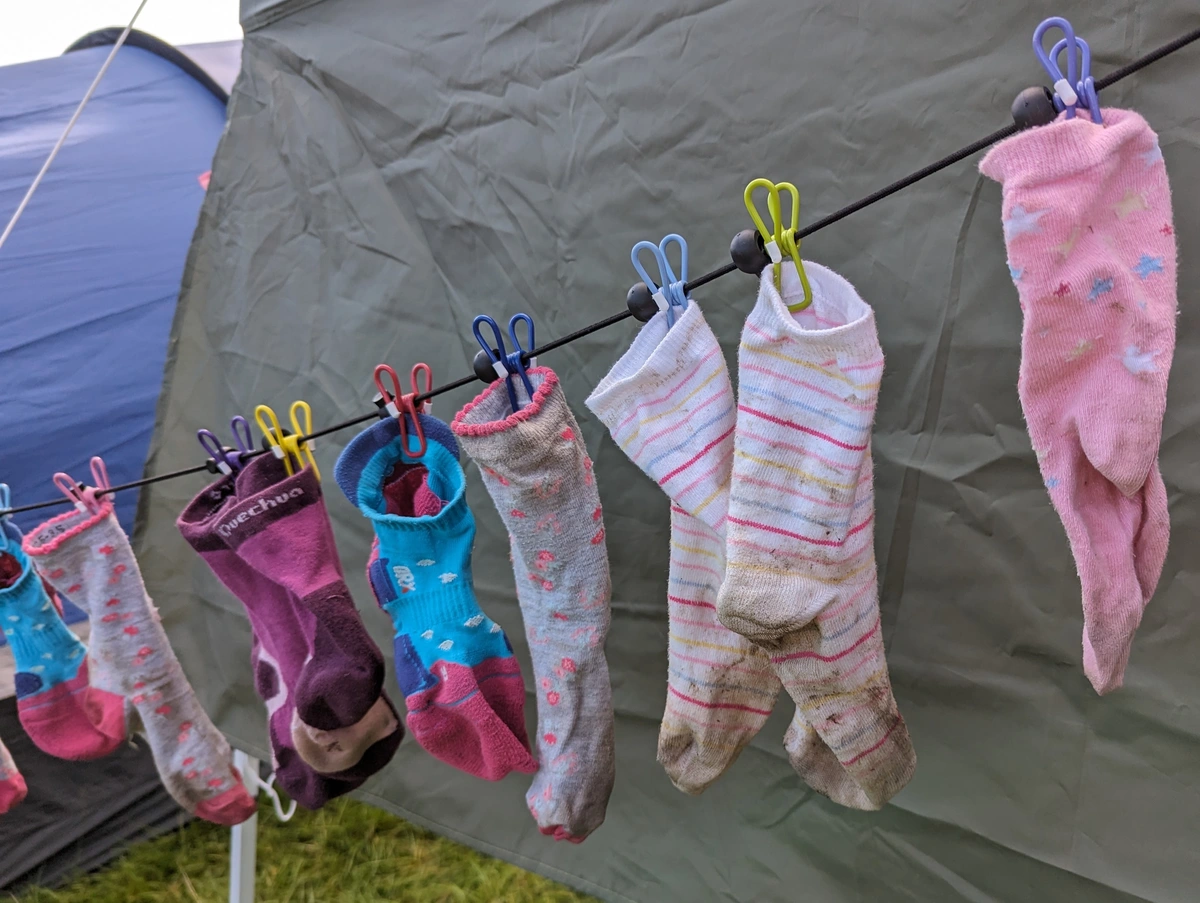
Technology
The advances in technology have to be some of the most profound changes we have seen since our early round-the-world trips in 2007. Back then, there was this amazing cheap new way to make international phone calls called Skype, and a cool new website called Facebook was the way to stay in touch with people you met as you travelled.
No one carried a laptop, and smartphones were in their infancy; the first iPhone was only released in June 2007. There was no public WiFi, and if you wanted to get online, you had to go and find a web cafe.
In many ways, the simplicity of 2007 was an advantage as we are now spoilt for choice! Phones, tablets, laptops, drones, GoPros – the temptation to overburden yourself is strong. So what do you need when travelling with kids?
Samsung Tablets with Bluetooth Keyboards.
For Georgia and Eva, tablets are great options. They are light, reasonably durable, reasonably cheap, and have a great battery life. They help to entertain and educate; they act as Kindles, play audiobooks and provide a distraction on long, boring bus rides, transfers or stopovers. If you are not sure if you will be able to get internet access, you can download shows to the Netflix or Disney+ app before you leave.
The addition of the Bluetooth keyboard does add a little more weight but makes them much more functional, especially when typing up their school reports or writing bits for this here blog!
Smartphones
We don’t need to point out how useful smartphones are while travelling. They are camera, navigation, research and communication combined. There is no point in making any recommendations because the market moves so fast that by the time you read this, it will be out of date! Just make sure it has a good battery and camera.

While you are away you will almost certainly rely on public Wi-Fi to stay connected to friends and family back home, which can present some dangers to your data. We explore this in detail here:
Staying Safe Online: The Importance of Using a VPN When Travelling with Kids.

While you are away you will almost certainly rely on public Wi-Fi to stay connected to friends and family back home, which can present some dangers to your data. We explore this in detail here: Staying Safe Online: The Importance of Using a VPN When Travelling with Kids.
Getting online and avoiding roaming charges is key to making the most of your phones while you are away. You can often buy a local sim card as you travel from country to country or you can download eSIM to most smartphones that cover whole regions. eSIMs tend to be more expensive but are quick and easy to configure and can be purchased before you leave.
Once you have data, you can then use WhatsApp to make free calls to any of your contacts. For our American readers, we know WhatsApp is not a big thing in the US, but pretty much the rest of the world uses it heavily. On our trip to Costa Rica, we used it for everything from organising surf lessons and arranging transfers to ordering room service. It would be worth installing it before you leave!
“Lipstick” Powerbanks
When you rely on your phone so much, the last thing you want to happen is to be stranded without it. We opted for two lightweight power banks with enough capacity to give both our phones one full charge and a little bit to spare.
We would recommend Auskang Power Bank 5000mAh, which weighs 83g and can fast charge to and from the USB-C adapter.
Laptops
When planning for a trip, it’s a good idea to think twice about whether or not you really need to bring your laptop with you. Laptops can be heavy and easily damaged or lost, so it’s important to consider if it’s worth the risk. We use our laptops for blogging and photo/video editing on the road, so it definitely has value to us. If we were not blogging, we would strongly consider only bringing a tablet or smartphone instead, which would do everything we need and be much lighter.
If, like us, you are planning to be digital nomads and work as you travel, there are some powerful, lightweight laptops that do a great job. We went with the Asus Zenbook Flip which packs a lot of punch into its 1,258g as well as having a 14-hour battery life. Incredibly, it runs off a USB-C adaptor, so you can use the same power adaptor for most of the other devices as well.
We also invested in a light, neoprene case to protect our laptops while in our packs.
GoPro
If you really want to try and capture as much as you can while you are away, then a GoPro is a must. These kickass little cameras are a triumph of engineering. They weigh next to nothing (155g) and can be flung out of planes, down zip lines, and taken underwater with little concern about breaking them.
As with my DSLR above, the danger with taking a GoPro is the extra weight of spare batteries, straps and cases. We were very strict and limited ourselves to a head strap, a floaty, a selfie stick and two spare batteries. In total, it all weighs in at 837g.
The other challenge of taking a GoPro is backing up and editing the footage on the road. You can edit it in the GoPro Quick App on a phone, but it is not the best, and you will very quickly fill up your phone’s storage. We go into more information on backing up your data on the road here:

If you are anything like us you will be taking lots of photos and videos of your little ones while you are away; we explore the best ways to keep them safe here:
Safeguarding Precious Memories – Securely Backing Up Photos and Videos While Travelling with Kids.

If you are anything like us you will be taking lots of photos and videos of your little ones while you are away; we explore the best ways to keep them safe here: Safeguarding Precious Memories – Securely Backing Up Photos and Videos While Travelling with Kids.
Drone
This is a real indulgence, but it has the capacity to create some incredible footage! Just like the GoPro, the drone itself is very light (249g), but the batteries, case and other bits quickly add up. The total weight of the drone and its controller comes to 1310g.
We felt it was worth it, again, because of the memories it can create and to get some amazing videos for the blog and our social media, but we would honestly question how useful it is for most travelling families.
One final word of warning: be sure to check what you can legally fly as the rules vary significantly from country to country. For example, drones are currently banned in India, and we have heard of people having them confiscated at Customs on the way in.
Our drone recommendation is the DJI Mini Pro 3. It is lightweight, captures amazing footage, and packs down very small.
One Charger to Rule Them All
Back in the 1990s, tech fan Douglas Adams wrote in “The Salmon of Doubt” about the nest of cables and dongles he had acquired from all his gadgets and asked why they could not run on the same connection. A mere 33 years later, his vision has come true; every device listed above charges on USB-C!
The saving in weight as we only need to take a couple of chargers and cables is huge. The only electric thing we have that is not USB-C is our toothbrush, but we are working on that!
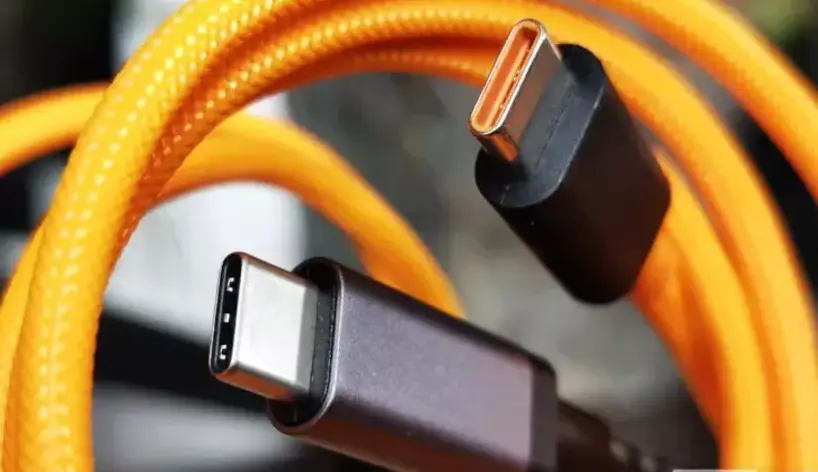
Health and Beauty
Let’s be honest; manicures and skincare routines are not at the top of anyones list of priorities when travelling, and many of the luxury items we use at home are just not practical on the road. When travelling, there is a line to walk between finding items we can live without whilst and not feeling like we have given up on life!
Beyond the beauty, there are practical items to consider when travelling with children like a good first aid kit, sunblock, and toiletries. Let’s start with the most important, our first aid kit.
First Aid
We carry two first aid kits, one full kit in our main backpacks and a much lighter day kit in our daypacks. The day kit rarely leaves our bag and covers everything you are likely to need while out and about such as:
- Assorted plasters
- Antiseptic wipes
- Tweezers (usually on a pen knife)
- Scissors
- Ibuprofen and paracetamol (when the girls were young we used to carry sachets of Calpol but they now take one 200mg pill)
- Small bandages and safety pins
- Tape
- Hand Sanitizer
Our main kit has spares of all of the above plus a selection of ‘just in case’ medicines and supplies:
- Rehydration salts
- Diarrhoea Tablets
- Antihistamines
- Bite relief cream
- Water purification tablets
- Motion sickness tablets
- Small pack of baby wipes
- Larger wound dressings
This does seem a lot, but from experience when you need something you need it now. You do not want to be chasing around at 2am trying to find the nearest open chemist.
A word of warning on carry-on luggage – don’t forget to remove scissors or penknife from your kit before trying to get through security!
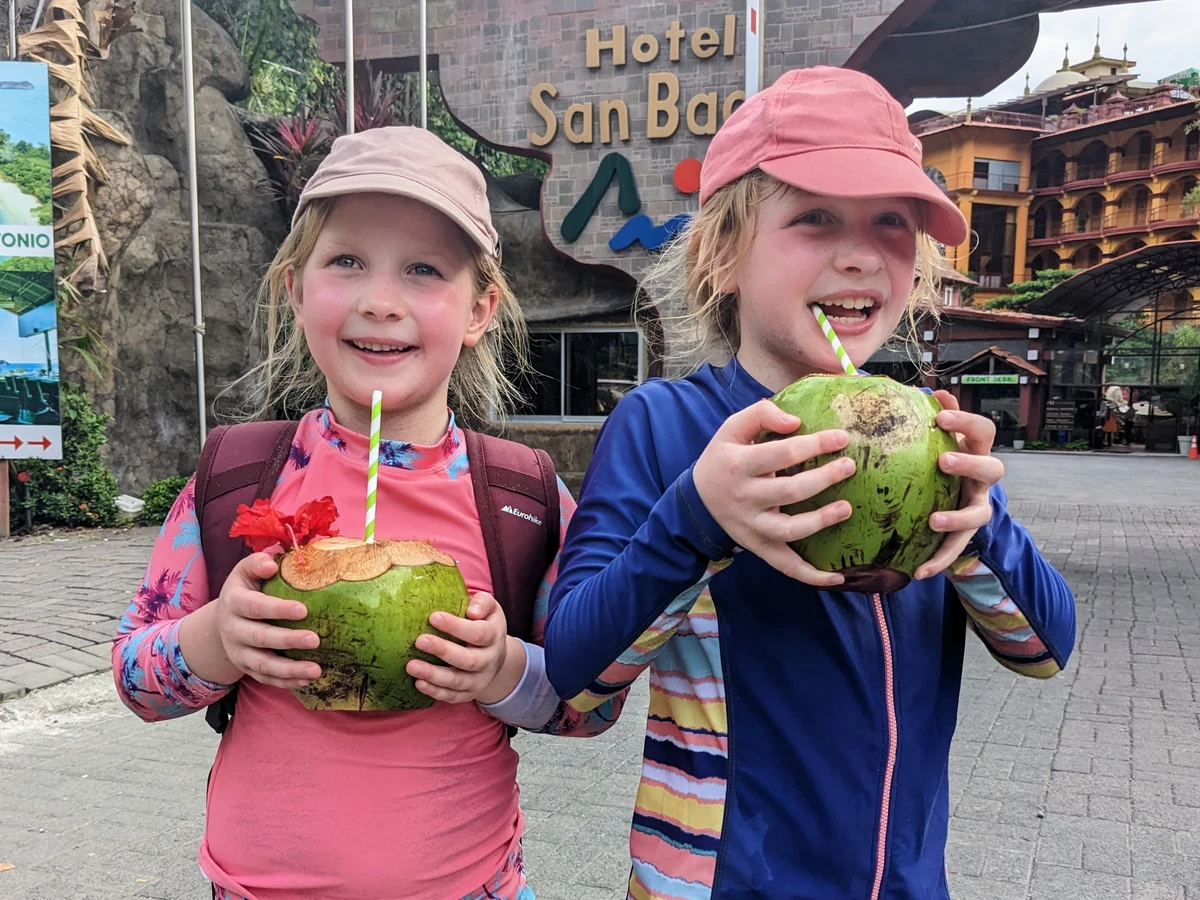
Sun Care
Home for us is Manchester, England. A famously cold, grey, and damp city at the best of times, so we are not used to a lot of sun. Although the girls have acclimatised well to the heat as we travelled, we still take daily precautions to avoid sunburn:
- Sun Hats – A must! They protect from UV rays and make life more comfortable by shielding the eyes and reducing squinting. The girls use either a rimmed hat or baseball cap that can be shoved in a backpack and not get misshapen.
- Light, Long-Sleeved Tops – Keeping the sun off your skin is the best form of sunblock and a long sleeve top can work wonders at protecting against UV. Not always practical at the beach, but great when exploring cities.
- Sunglasses – These are important but can be a bit tricky! The girls are very good at breaking or losing their sunglasses and replacing them with quality ones that have proper UV shielding is key to protecting their eyes, especially at their age. Cheap “tourist tat” sunglasses may not give the right protection so we look for proper opticians or a pharmacy when needed. If we need to replace our prescription sunglasses, we keep a copy of the prescription on our Google Drive.
- Suncream – This is a funny one; in the UK, it is readily available year-round for the three days of summer we actually get, but we have often found it hard and very expensive to buy whilst in South America or South East Asia. Due to its weight, it is impossible to carry an endless supply, but you don’t want to be caught without, so grab some when you can. The best place in the world to buy suncream is Australia, where you can get it by the litre! We usually carry a couple of bottles of 200ml Factor 50 Waterproof suncream and a couple of pocket-sized travel ones for short trips. They are also useful if you have just got carry-on luggage. If you plan to spend time near the coast look into purchasing marine-safe sun cream, which won’t leach out into the water and coral.
- Fans – Keeping the girl’s core temperature down is key to avoiding heat stroke, especially in the first few days we arrive into a hot climate. We carry small, battery-powered fans that they can use to cool off a little if it is getting too hot.
- Aftersun – There is debate on whether straight aloe vera lotion or aftersun containing the plant is better if you need burn relief. This comes down to personal choice, but we prefer aloe vera. It can feel a bit sticky but is great for more localised applications. If you can, put the bottle in the fridge before you use it; bliss!

It takes time for you and your kids to adjust to a hot climate and we explore this and some of the dangers associated here: Staying Safe from the Sun: Avoiding Sunburn and Heatstroke When Travelling With Kids.

It takes time for you and your kids to adjust to a hot climate and we explore this and some of the dangers associated here:
Staying Safe from the Sun: Avoiding Sunburn and Heatstroke When Travelling With Kids.
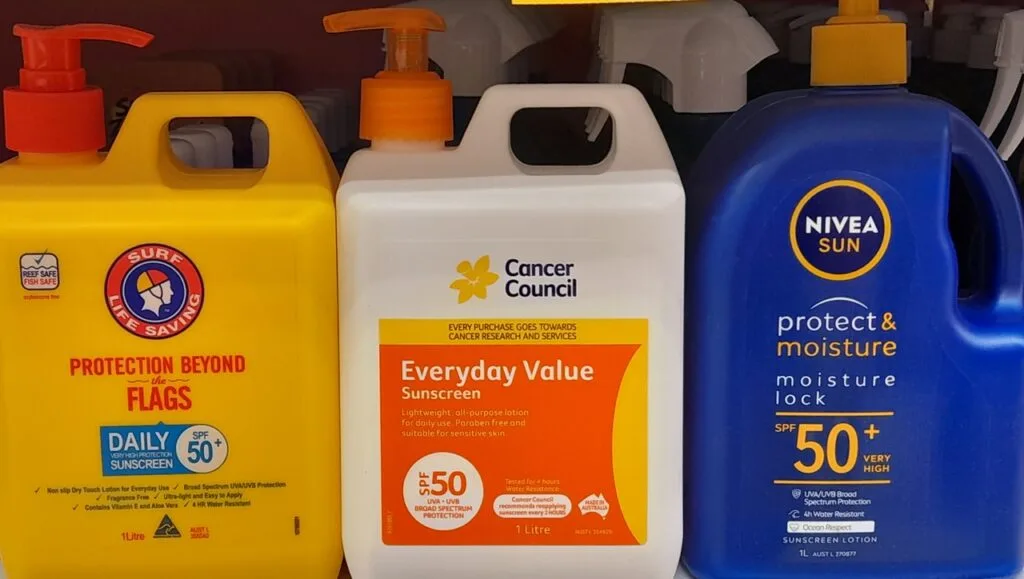
Insect Repellent
Nobody likes an irritating and itchy mosquito bite. However, in some areas, mosquito-borne diseases mean protection from them is important. Over the years, we have tried different bug sprays based on Deet and picaridin-based and found them to be about the same level of effectiveness. That said, picaridin repellants smell much better and don’t melt your bag when they leak.
We have also tried the mosquito repellent bracelets but have not found them to be of much use.
Toiletries
We travel pretty light while away and have ditched all the fancy face creams and hair straighteners. We carry:
- One electric toothbrush with four heads – keeping it charged can take some effort, but we wouldn’t be without and electric toothbrush and didn’t want the weight of carrying individual ones.
- Toothpaste – We have just hit the stage where the girls will use adult toothpaste, so one tube will do us all; however, age-appropriate toothpaste is still important for younger children.
- Dental Floss – Floss or interdental sticks are small and lightweight. The telling-off we get from the dental hygienist at home means these products always make the list. We start with a reasonable supply and grab it when we can whilst away.
- Combined Shampoo and Conditioner – Many accommodations will provide it but, you never know, so we always carry some. At home, we use solid shampoo bars, but finding ones that suit your hair takes a bit of trial and error and aren’t readily available everywhere, so we just stick to traditional liquid options. Even with lots of long hair in our family, an all-in-one saves space and weight so we usually use these.
- Combined Soap and Shower Gel – As with shampoo, soap and shower gel are usually available at your accommodation. However, we carry a small one of each for when there isn’t any.
- Refill Bottles – We also carry 100ml silicone refillable bottles to fill with shampoo and shower gel when we travel with just carry-on luggage.
- Feminine Hygiene – This is essential if you are a lady of a certain age and is very much a personal thing. Menstrual cups are great if you can use them; not only are they better for the environment but they save a lot of space.
- Deodorant – Again, this comes down to personal choice. Various types are readily available worldwide, so we pack one to get started and grab more when required.
- Moisturiser – All the anti-ageing creams and serums are staying behind! This is a bit of a sacrifice; however, having a good all-in-one lotion/moisturiser is more practical.
- Hand Sanitiser – We carry a small one in our day packs and a larger one that works as a refil.
- Babywipes – Again we carry a small pack in our day pack and a larger one in our main bag. Always handy for cleanups of all sorts!
Food and Drink
You might think this is a strange category, but stick with us! Over on our “Managing Your Money While Travelling with Children” post, we go into how we save money on food when exploring new places by “Make and Take” – i.e. making food in the morning and taking it with us for a picnic lunch.
There are a few lightweight things you can carry that make this much easier and will save you money on the road.
Reusable Silicone Bags (40g) – These weigh next to nothing, are resealable, fold down very small and are a hygienic way to transport sandwiches, slices of pizza or pastries! They also can be used as plates and are easy to clean and quick to dry. We usually carry 5 of them.
Silicone Collapsable Travel Mug (166g) – This is a bit of an indulgence, but as coffee lovers, we couldn’t do without it! We carry a travel mug to take a cup of coffee with us when we set out in the morning. We either make it where we are staying or fill up from the breakfast buffet. It saves us from buying coffee, and honestly, you can’t put a price on a good coffee in the morning.
Camping Cutlery Set (95g) – This makes cutting up an apple or splitting a pastry that much easier! We have tried all sorts of different ones but found a simple plastic set to be the best. Weighing in at 95g and costing just £3.60, the Ellipse Camping Cutlery Set is the best. We carry two sets for the four of us.
Silicone Collapsable Water Bottles (340g) – Staying hydrated is key when you are spending all day out and about, but metal water bottles are bulky, and we have found bladders a bit too prone to leaking. After much trial and error, we now use silicone collapsible water bottles. These bottles weigh very little and collapse down surprisingly small when not in use. Also, they reduce the number of plastic bottles we use.
We have tried and given up on water bladders. They seem to love to leak at the worst possible moment.
Entertainment and Education
When it comes to packing toys, it can be very hard to explain to a seven-year-old about airline weight and space limits. Before we left, we took a lot of time to help Georgia and Eva understand why they couldn’t they bring their entire toy box. This is how we did it:
- First. we started by talking to the girls about the trip, how long we will be gone, and what life will be like day to day. This way they started to understand what sort of toys they would need.
- Next, we made a list of what they wanted to bring with us. We then discussed the list, explained which toys were impractical and prioritised what was left.
- Finally, we set a space limit and encouraged the girls to choose the toys they thought they would play with the most. Although it wasn’t easy, we did arrive at a selection of toys and teddy’s that Georgia and Eva really treasure.
Making the decision on what to leave behind was the hardest part. Once we were away, seeing and experiencing all those new things, the girls soon forget about the toys left at home and focused on all the unique experiences in front of them. So many times on our shorter trips we have packed books, colouring, teddies, and toys that haven’t been looked at once.
What to Take
Apart from the girl’s chosen toys, we packed the following which also form a big part :
Colouring – One set of pens, one set of coloured pencils, and a small pencil case with all the other bits they need to work and create. Adrian found a great set of roll-up colouring pencils which are lightweight, and compact and helps make sure you don’t leave any behind as each pencil has its own slot.
Paper – Georgia in particular is very creative and loves writing, drawing & crafting so we are taking a plain and lined writing pad for the girls to share. They also have dedicated workbooks for their schoolwork. Aside from this, we always have a couple of small puzzle books kicking about as they are great for stimulating young (and old!) minds on journeys.
Travel Journals – Keeping a journal has been on our packing list for a long time. Not only does it build a permanent keepsake for us to look back on in years to come, but it is also a fun way to get the girls to engage in writing. With so much of their school work being online now, old-fashioned handwriting often gets forgotten. There are many different styles of journals to appeal to different age ranges. A friend of ours bought the girls these lovely travel journals, which are straightforward to fill in and keeps everything in a structure. Flicking back through will make for easy reading and let them relive their journey.
Travel Games – Uno has lived in Kirsty’s handbag for many years. It always keeps your fidgety little munchkins still whilst their dinner arrives! However, over the past 12 months, we have opted for a good old-fashioned pack of playing cards as well. They are so versatile and we can choose a game to fit the time we have. Playing cards are great as it is a sneaky way to add maths into their playtime! Adrian had well used waterproof pack of cards in a metal tin from his solo travelling time which is making another appearance. Another family favourite is ‘Pass the Pigs‘, introduced to us by the Australian side of our family. It is a compact, lightweight game which never fails to entertain us. We always keep these games on us as you never know when you need to whip it out and ease the boredom.
Soft toys – Our girls still love their teddies! Georgia has two small teddies she has slept with ever since she was tiny, so for her it was a no-brainer! Eva however, has a huge squishmallow she has christened ‘Cookie’ that trails around with her. Although impractical for long-term travel, Cookie has been a great travel pillow and comfort to Eva over the past 12 months on shorter trips (she even came to Costa Rica and took up most of her suitcase!). She is very attached to her so we have agreed to find Cookie’s younger sister, (ie. a much smaller version of her little friend) and another small teddy to take with her. Having these home comforts is essential when they get a little homesick.
Toys – If your children are of an age where they still like doing roll play then consider letting them take something small that will keep them entertained. Our girls are still into toys like Hatchimals and LOL dolls and do often go off together to play with them. Although not ideal travelling toys due to the size and little accessories that are easy to lose, we let them take a couple of small toys with them. The rule is they need to fit into a small packing cube.
Binoculars and Magnifying Glasses – Georgia especially loves spotting wildlife and getting up close to bugs so we always carry a couple of pairs of lightweight children’s binoculars and magnifying glasses with us. Perfect for trips to the rainforest!
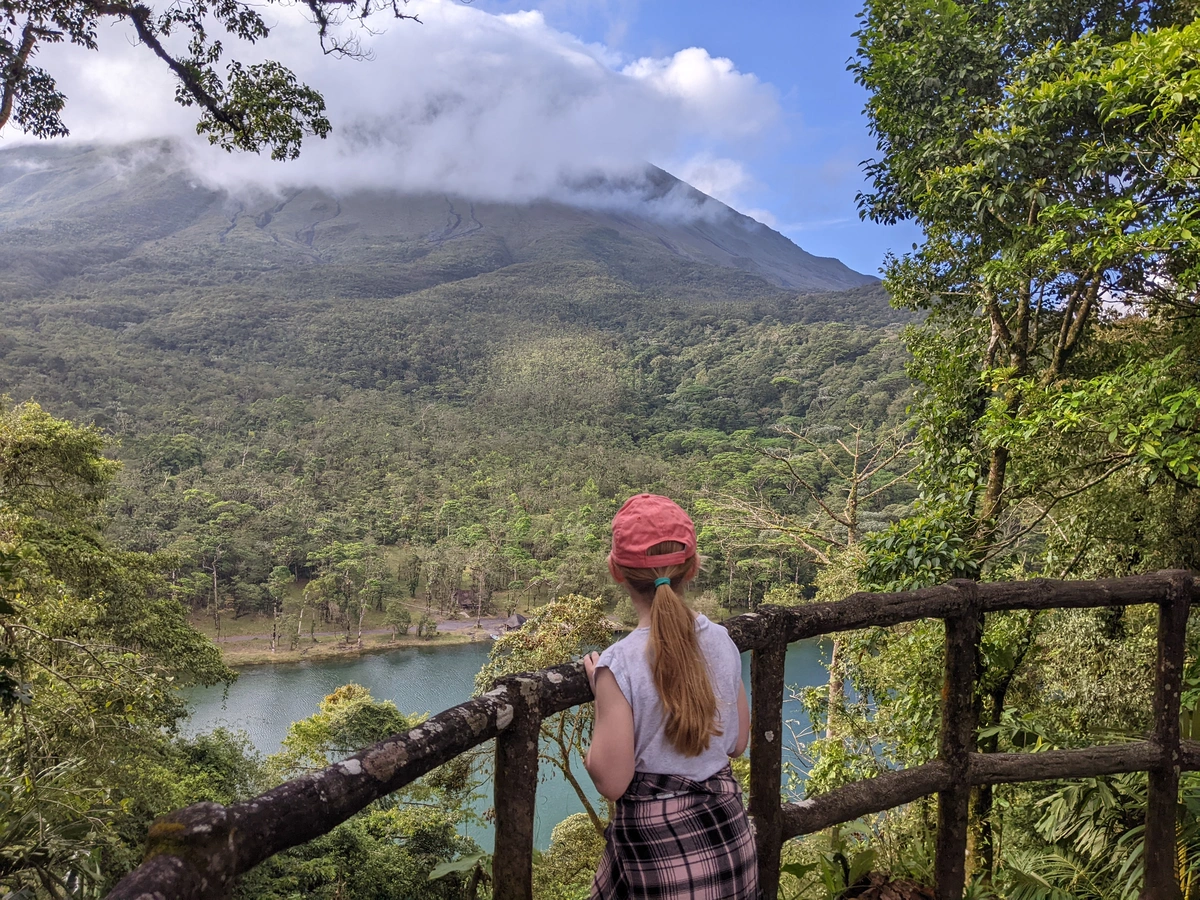
Obviously, you can find most of the above anywhere in the world so replacing things or treating the girls to new toys is not a problem if something gets lost.
Keeping Things Safe and Secure
When you are travelling, there is a constant need to keep certain items secure. Passports and tablets might be left in your room. Cash and bank cards might be left on the beach when you go for a dip. Vaccine records and laptops might be left in storage when you go for an overnight excursion. The loss of any of these would be a headache, and while no system is foolproof, there are things you can pack that will certainly deter opportunistic theft.
In Your Room
When we leave any items like credit cards or debit cards in our room, we use the Pacsafe Travelsafe bag (660g) which is the ideal size for tablets and passports and bank cards. It has a high-tensile steel cable that you can fasten around a bed frame or other immovable object and is made of a slash-proof mesh. We are still using the same one Adrian bought 15 years ago so we can safely say it has been effective!
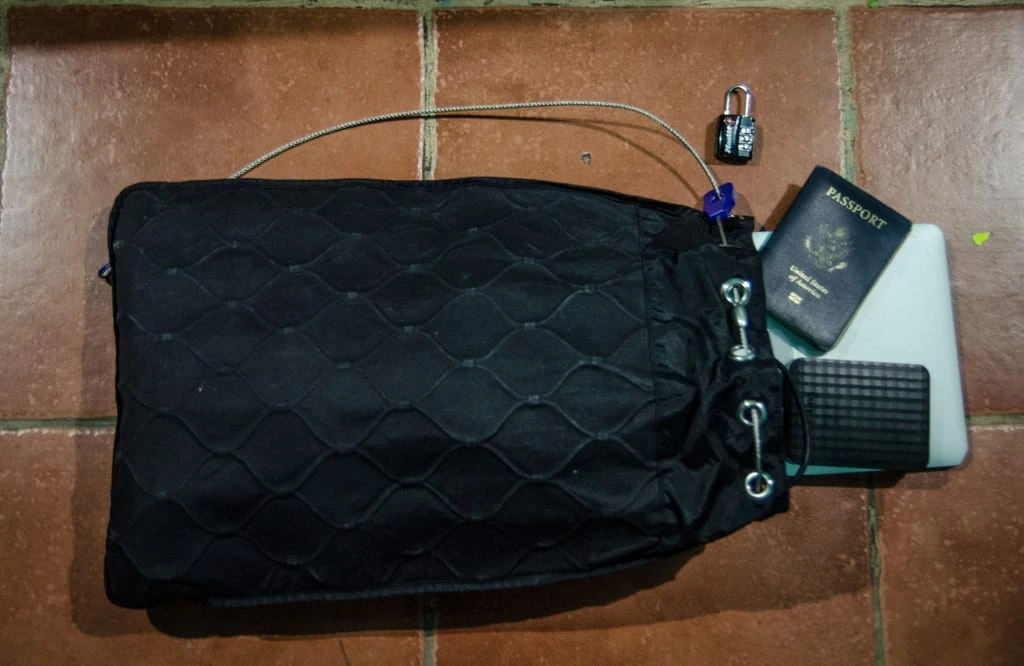
Leaving Your Backpack
When we are doing an overnight excursion with just a daypack and want to secure an entire backpack, we use the Pacsafe Bag Protector (or as we call it, “the hay net”). Like the Travelsafe, the Bag Protector has a steel cable to secure the bag to any sturdy bit of metal work and stops anyone from opening the main compartment. It is available in various sizes so you can get one that fits your bag no matter the capacity.
One word of warning with this, unless the protector fits your bag perfectly, there is a chance someone could wiggle things out of side pockets so be careful what you leave in there.
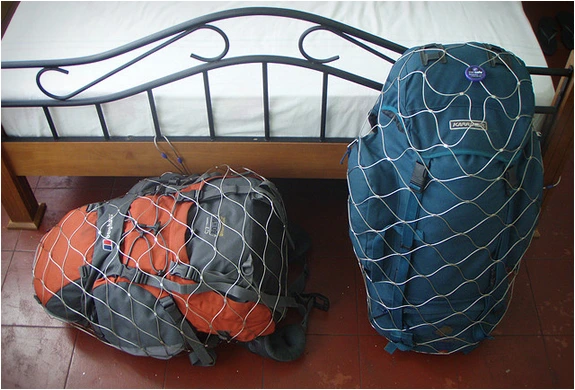
Out and About
When out exploring, the most vulnerable thing you will carry will be your bank cards and cash. To protect them from scanner fraud (always a risk on crowded public transport), it is worthwhile investing in RFID blockers to stop the signal. These cards sit on either side of your purse or wallet and deflect the nefarious scanner signal away from your card.
Another option is a card case with the blocker technology integrated. Adrian uses the Ekester aluminium card holder carry case that not only looks cool but also Blocks RFID to prevent wireless theft. It even has the option of a tracker card to make them much harder to lose!
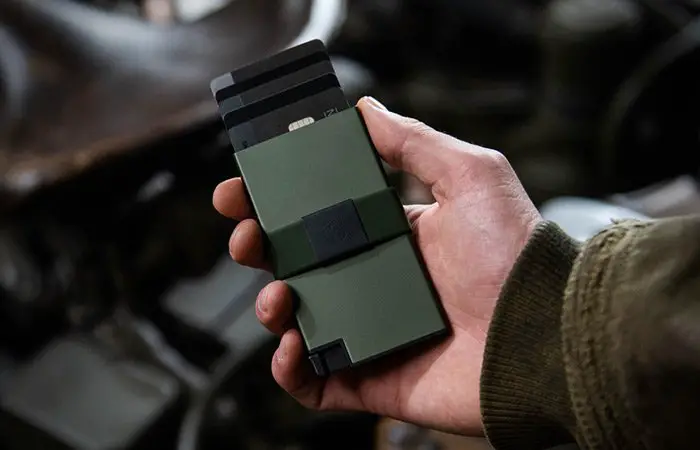

Unfortunately, spotting and avoiding scams is part of travelling; we explore some of the most common and the steps you can take to avoid them here: On the Road With Children: Safeguarding Against Travel Scams.

Unfortunately, spotting and avoiding scams is part of travelling; we explore some of the most common and the steps you can take to avoid them here:
On the Road With Children: Safeguarding Against Travel Scams.
If you are at the beach, then keeping cash and cards on you when you take a dip is the best option. Modern cash and bank cards are waterproof to a point. If bank cards are kept in salt water for too long, the glue that holds the chip in place can come loose and render the card useless, so if you are planning a lot of beach time (lucky you!) it may be worth investing in a waterproof card holder.
When Travelling
We have all seen news stories of people putting Airtags in their baggage, which then go on a merry adventure and arrive in the wrong country two days late. We are Google Pixel users, and for the time being there is no equivalent system although one has been promised for a while. Samsung has its own version, which annoyingly is locked to its ecosystem. Watch this space, and as soon as something hits the market, we will surely try it!
Useful Bits
There are some very handy things to carry that don’t fit neatly into any of the categories above. Please forgive us if this section is a bit all over the place; by its nature, it is a bit of a mess!
- Huntsman Swiss Army Knife (97g) – Literally the Swiss Army Knife of tools! Compact, light, and with 1001 uses, having one of these in your pack is a must. We carry The Huntsman, which is a nice balance of size and utility.
- Sewing Kit (99g) – It is very handy to be able to patch things up on the run, be it trousers or teddy bears. A sewing kit weighs very little but offers a lot of functionality.
- Cash Stash Keyring (10g) – We have a few tucked around our cases and key chains with emergency funds and copies of our key paperwork.
- Scans and copies of all major documents like passports and birth certificates – Kind of obvious! We keep digital copies on our Google Drive and physical prints in….
- Waterproof Document Case – Useful to store important paperwork and things like vaccine records. Even if your bags get soaked, the docs will be fine.
- Plastic carrier bags – With the battering your backpacks will get, it is not surprising that things like shampoo or suncream will occasionally leak so we always have a couple of plastic bags on hand to wrap things in. They are also useful for any wet swimming gear or even for carrying your shopping!
- Baggage Scale – We mention this above, but it is worth repeating: having your own scale adds a few grams, but it means you can check before you get to an airport if your bags are overweight. It is far easier to repack in a hotel room than on an airport lounge floor.
- Microfiber towel – Light-weight and folds down to a tiny size; this is a must. It can also double as a beach towel. Just ignore the fact that drying yourself with it is far from great!
Any Long-Term Travel Packing Suggestions?
So there we have it, our “The Ultimate Long-Term Travel Packing Guide for Families” and by far the longest and most detailed post we have ever written!
If we have missed a great packing tip or there is an indispensable item not included, please let us know in the comments below!
